Grass looking greener on the other side? Well, perhaps it’s because your neighbours have learnt the simple science of composting. Compost is like pure gold to any type of garden – a multivitamin of sorts for all greenery. Good compost enriches the soil with all the nutrients plants need for proper growth.
In turn, gardeners get healthy, fast growing plants with deep, strong roots and vibrant, bountiful blooms. But composting isn’t just a good way to nourish your crop; it’s also an environmentally friendly alternative to throwing everything in the trash. Are you ready to reduce your carbon footprint?
Although composting takes some time and effort, it’s actually an easy process. In fact, the simplest method of home composting involves starting an open pile somewhere in a far corner of your yard.
However, there are a few setbacks to open composts. They tend to be extremely smelly, unsightly, and will attract all sorts of pests and foraging rodents. What’s more, it could be against some residential regulations in your area to start an open compost.
Instead of just throwing a compost pile in the backyard and leaving it at the mercy of nature, you need the correct environment that won’t be compromised. And to create high quality compost, you actually need a dark, aerated environment with the right temperature and moisture levels.
And that’s why any serious gardener will always have the best compost bin. But with all the different options, how do you know which one is best for you?
Key Considerations When Buying a Compost Bin
a) Types of Compost Bins
- Standard – These are affordable, low maintenance options that generally don’t come with any specific features. They are cheaper and easier to use, but will require manual aeration.
- Tumbling or Rolling Bins – These are basically barrels fitted with a crank that lets you easily turn and aerate the materials for better, faster composting. However, these types are smaller and more costly.
b) Features and Extras
Depending on what you are trying to do, there are plenty of features which may or may not matter. However, it helps to get a model with a charcoal filter or some form of absorbent property so you don’t get bad smells. You could also opt for a model with a compost tea spigot if you want richer fertiliser.
The Best Compost Bin Reviews
1. 4smile Garden Composter Bin Review
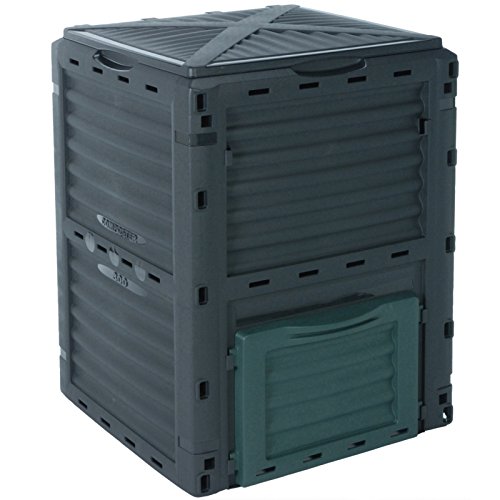
Looking for a large composter worth the money? Made from tough, hardy plastic, the Eco Friendly Waste Box from 4Smile comes with a fairly large 300l capacity. The composter is delivered in a compact, flat package that is quick to assemble thanks to the easy click system.
The neutral colour scheme and square shape of this model allow it to fit neatly and discretely in the corner of your yard. What’s more, the darker colour encourages better heat retention. Looking at all the panels, you’ll notice there are ventilated openings to let in enough oxygen. At the top is a hinged lid for easy access to dump waste while keeping pests and rodents out. This high quality composter is as good as it gets for the size and price.
What I like about it:
- Durable high quality construction
- Practical square shape and discrete colour scheme
- Hatch door at the base for easy compost removal
2. Blackwall 220L Composter Converter Review
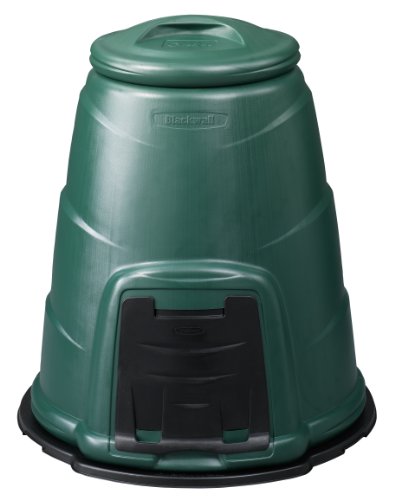
Do you have a small garden with minimal waste and are just looking for a convenient way to recycle and compost? Then what you need is the Blackwall Composter Converter. The unit itself is made from recycled plastic and has a 220 litre capacity. The green colour scheme lets the composter blend into the background.
At the top is a push fit lid that has been proofed against wind to prevent blowing off in strong winds or leaking of unwanted smells. The recycled plastic keeps pests at bay while the wider base gives the composter more stability. Blackwall also included a front hatch for easy shovelling of the ready compost.
What I like about it:
- 100% recycled plastic construction
- Tight wind proof push fit lid
- Optional base plate for more stability
3. Primrose Large Outdoor Wooden Compost Bin Review
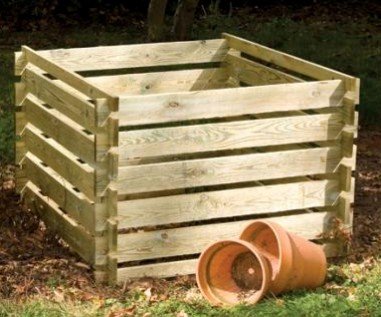
Are you serious about your composting? Then you’ll need an equally dedicated compost bin for the job. Covering an area 44 inches long, 44 inches wide, and 27 inches high, the Primrose Large Outdoor Wooden Compost Bin boasts of a massive 893 litre capacity. This bin is made of a traditional wooden build that not only blends naturally in any garden, but has been also pressure treated against wood-rot for up to 15 years.
What really impresses is that even though the wooden bin comes flat-packed, you don’t need any tools to assemble it. You won’t need any nails, hammers, screws, or even pre dug holes in the ground. The wooden pieces just slot together easily from the bottom to the top to create a basic square bin. The slats also leave a space in between each for easy airflow through the compost.
What I like about it:
- Large composting capacity of 893 litres
- Extremely easy to assemble; no tools required
- Economic and eco-friendly traditional wooden construction
4. Envirocycle Composting Tumbler Bin Review
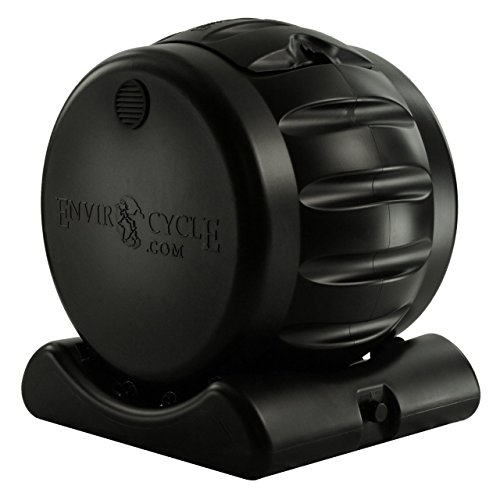
Looking to make some of the highest quality compost and nutrient packed fertiliser for your garden and lawn? Then you’ll need a bin that takes the work out of composting. The Envirocycle Composter is an all in one indoor outdoor composting system that combines a 133 litre tumbler drum with a manure tea maker at the bottom.
The drum rotates at the top to mix and turn plant matter which speeds up the process and creates higher quality compost. As time passes, liquid collects at the bottom of the drum as compost tea which is a very rich and precious fertiliser. The bin is made of food safe BPA and rust free materials with a compact, stylish design that can be placed even close to your home, balcony, deck, or patio.
What I like about it:
- Beautiful and stylish design
- Solid safe and protected construction
- Two in one composter and liquid fertiliser maker
5. Whitefurze 220L Compost Bin Review
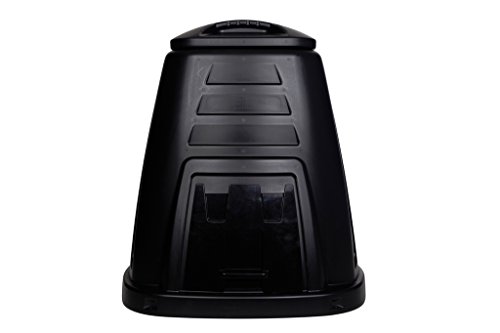
If you’re just starting out your journey towards reducing your carbon footprint, then the Whitefurze 220L Compost Bin is the ideal option for first timers. The 220 l capacity is more than enough for small to medium homes with average waste and garbage.
The bin itself is made from robust, durable recycled plastic materials that can withstand the rigours of regular use. Just like the unit from Blackwell, this one also has a push fit wind proof lid with an easy grip handle to open and regulate temperatures inside. Similarly, there’s also a removable front hatch for easy shovelling of compost.
What I like about it:
- Hardwearing and robust recycled plastic construction
- No assembly required
- Removable windproof lid
Frequently Asked Questions
Q: Where can I put my compost bin?
Look for a level area so your compost bin will have a sturdy base. If you plan to add kitchen scraps to it (Bokashi composting method is great for those), then it is a good idea to have it accessible to the back door (or just use a small container for scraps in the kitchen, and empty it into the large bin regularly).
It is a good idea, especially if you live in a cooler area, to look for a sunny spot in your garden, so the bin will receive heat from the sun to speed up the composting process.
It is better to place your compost bin over soil or lawn rather than concrete – this way you will be able to get the benefit of worms and other decomposers that will come up from the soil and help the process.
Also, you will avoid any nasty seepage from the compost on your pristine stonework! If you plan to use your compost bin’s produce on your veggie garden, then it is a good idea to site it close to the areas you want to spread compost on, to reduce the amount of wheelbarrowing you will have to do.
Compost bins can get a bit smelly, so if you want to stay on the right side of your neighbours then it is best to place it out of sight – and smell – of them.
Q: How does a compost bin work?
Compost bins are an amazing addition to any garden; they create beautiful, nutritious compost for your plants in a quick and convenient way. They use natural composters like bacteria, worms, fungi and other micro organisms to break down organic matter and turn it into well rotted compost.
Compost bins need a supply of oxygen, moisture, nitrogen and carbon in order to work effectively – garden materials that you place in your compost bin are rich in nitrogen and carbon, so all you need to do is ensure there is a bit of an air flow.
Effective composting also requires heat, which, conveniently, is produced by the decomposing process.
You can buy a very simple compost bin, which is a tall cylinder with an opening at the bottom, covered by a removable door. You simply place your lawn cuttings, twigs, chicken coop clearings, kitchen scraps or other compostible materials into the top, replace the lid and wait.
Before too long, your compost bin will be bulging at the seams with rich, dark compost, which you simply scrape out from the bottom opening and spread on your garden.
The downside to this type of compost bin is that the things you put into it don’t mix together very well, so you can either turn it over with a fork occasionally, or invest in a compost bin with a tumbler built in.
Q: What can I put in my compost bin?
There are some things you should NOT put into your compost bin, as these things will ruin the composting process:
- Dog and cat faeces
- Cooked food
- Dairy products
- Bones, fish and meat
- Citrus peels
- Ash
Pretty much anything else goes, as long as it is organic material.
Q: How to get rid of rats in a compost bin?
Rats are drawn to the food sources, and the warmth and shelter, of a compost bin, so you should remove these things to discourage these pests.
Meat and dairy are sure-fire rodent attractors, so you should always avoid putting these things in your bin.
If you are adding food scraps such as vegetable peelings to your compost bin, bury them down a little beneath the existing layer of composts, so the smell is masked.
Keeping your compost bin moist will deter rats, as they like a dry home. Don’t soak it, as this will inhibit the composting process, but keeping it moist will deter rats.
Planting mint nearby is also a possible rat deterrent – rats and mice apparently don’t like the smell, so it is definitely worth placing a plant or two near your bin.
A solid compost bin is better at keeping rats out than a pile, so if you have a problem with rats in your pile then consider moving it all into a bin.
If you regularly aerate your compost, by turning it over with a fork once in a while, you will lessen the chances of a rat setting up home.
Leftover onions are also reported to keep rats away, so it is worth placing one or two of these around to repel rodents.
You could also try ultrasonic rat repellents; these are quite effective but bear in mind that they can also disturb other wildlife in the vicinity.
You can set humane traps, to physically remove the rats – but you will have to take them a few miles away to prevent them coming back.
If you are a fan of the feline, you could consider getting a cat – these predators are generally very helpful at getting rid of rats.







